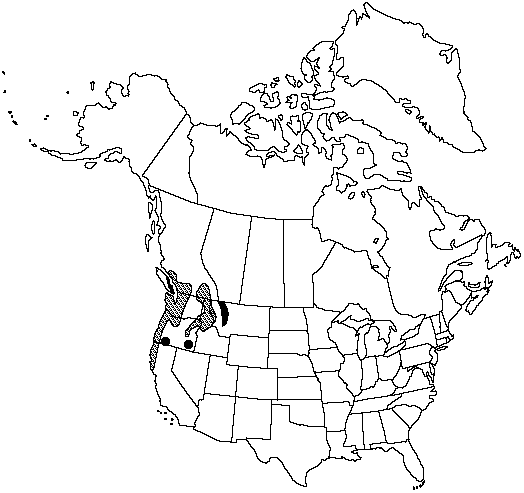Abies grandis
Penny Cycl. 1: 30. 1833.
Trees to 75m; trunk to 1.55m diam.; crown conic, in age round topped or straggly. Bark gray, thin to thick, with age becoming brown, often with reddish periderm visible in furrows bounded by hard flat ridges. Branches spreading, drooping; twigs mostly opposite, light brown, pubescent. Buds exposed, purple, green, or brown, globose, small to moderately large, resinous, apex round; basal scales short, broad, equilaterally triangular, slightly pubescent or glabrous, resinous, margins entire, apex pointed or slightly rounded. Leaves (1–)2–6cm × l.5–2.5mm, 2-ranked, flexible, with leaves at center of branch segment longer than those near ends, or with distinct long and short leaves intermixed, proximal portion ± straight, leaves higher in tree spiraled and 1-ranked; cross section flat, grooved adaxially; odor pungent, faintly turpentinelike; abaxial surface with 5–7 stomatal rows on each side of midrib; adaxial surface light to dark lustrous green, lacking stomates or with a few stomates toward leaf apex; apex distinctly notched (rarely rounded); resin canals small, near margins and abaxial epidermal layer. Pollen cones at pollination bluish red, purple, orange, yellow, or ± green. Seed cones cylindric, (5–)6–7(–12) × 3–3.5cm, light green, dark blue, deep purple, or gray, sessile, apex rounded; scales ca. 2–2.5 × 2–2.5cm, densely pubescent; bracts included. Seeds 6–8 × 3–4mm, body tan; wing about 1.5 times as long as body, tan with rosy tinge; cotyledons (4–)5–6(–7). 2n =24.
Habitat: Moist, coastal coniferous forests and mountain slopes
Elevation: 0–1500m
Distribution

B.C., Calif., Idaho, Mont., Oreg., Wash.
Discussion
Abies grandis is rather uniform morphologically and chemically. At its southern limit in southern Oregon and northern California, it introgresses with A. concolor (J.L. Hamrick and W.J. Libby 1972; E.Zavarin et al. 1975; D.B. Zobel 1973). In the area of introgression, specimens in lower, wetter habitats are best assigned to A. grandis; those in higher, drier habitats, to A. concolor. Others are best considered to be A. concolor × grandis.
Selected References
None.
